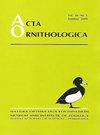Wall Structure Affects Insulation of Nests Built by Thrushes
IF 1.3
4区 生物学
Q3 ORNITHOLOGY
引用次数: 7
Abstract
Abstract. Incubation and rearing of nestlings are energetically demanding activities that can be affected by insulation conferred by the nest wall. Although thermal properties of nests are widely studied, no reports to date have dealt with the relative effects of the various structural parts of the nest wall. This experimental study investigated the effects of air movement, and for the first time, the effects of wall structure, on nest insulation for the Common Blackbird Turdus merula and Song Thrush Turdus philomelos of the Turdidae. Insulatory values, i.e. difference in cooling rate measured simultaneously inside and outside a nest, and internal cooling rates within the nest cup, were determined using temperature loggers under still-air and moving-air conditions. Moving-air increased insulatory values and internal cooling rates in both species. Insulatory values were positively correlated with the nest base thickness, but not nest side wall thickness. Removal of the outer nest wall and cup lining to reveal the internal mud cup of thrush nests reduced the insulatory value compared to the whole nest, the effect of which was exacerbated under moving-air conditions. These results may reflect that the nest wall confers huge insulatory advantages and especially so during periods of air movement. However, it is unclear whether this is related to the presence of particular nest materials that confer insulation, or to the amount of air trapped in the nest wall. Alternatively, the thermal conductivity of the materials lining the cup wall may be important.墙壁结构影响画眉筑巢的隔热性
摘要孵化和饲养雏鸟是一项需要大量能量的活动,可能会受到巢壁保温的影响。尽管巢的热性能被广泛研究,但迄今为止还没有报道涉及巢壁各结构部分的相对影响。本实验研究了空气运动对鸫(Turdus merula)和鸫(Turdus philomelos)巢保温的影响,并首次研究了墙体结构对巢保温的影响。在静止空气和流动空气条件下,使用温度记录仪确定隔热值,即同时测量巢内外的冷却速率差异,以及巢杯内的内部冷却速率。流动的空气增加了两个物种的绝缘值和内部冷却速率。保温值与巢底厚度呈正相关,与巢壁厚度无关。去除巢外壁和杯衬,露出内部泥杯的画眉巢,与整个巢相比,保温值降低,在流动空气条件下,保温效果加剧。这些结果可能反映了巢壁具有巨大的隔热优势,特别是在空气流动期间。然而,目前尚不清楚这是否与提供绝缘的特殊巢材的存在有关,还是与困在巢壁上的空气量有关。另外,衬里杯壁的材料的导热性可能是重要的。
本文章由计算机程序翻译,如有差异,请以英文原文为准。
求助全文
约1分钟内获得全文
求助全文
来源期刊

Acta Ornithologica
生物-鸟类学
CiteScore
2.10
自引率
0.00%
发文量
14
审稿时长
>12 weeks
期刊介绍:
Publishes scientific papers (original research reports, reviews, short notes, etc.) and announcements from all fields of ornithology. All manuscripts are peer-reviewed.
Established in 1933 as Acta Ornithologica Musei Zoologici Polonici, since 1953 continued under the present title.
Published twice a year by the Natura Optima Dux Foundation under the auspices of the Museum and Institute of Zoology, Polish Academy of Sciences.
 求助内容:
求助内容: 应助结果提醒方式:
应助结果提醒方式:


